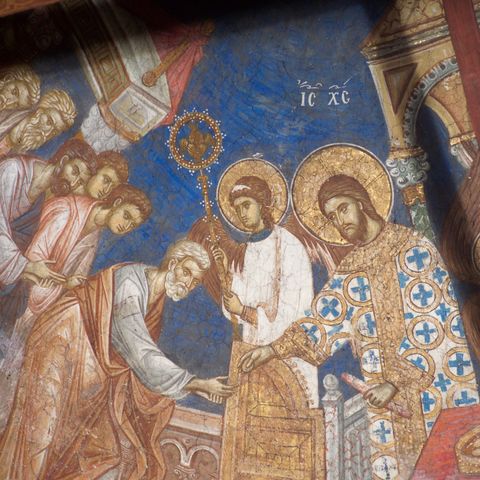Divine Liturgy - Class 1

Download and listen anywhere
Download your favorite episodes and enjoy them, wherever you are! Sign up or log in now to access offline listening.
Description
A class on the Divine Liturgy, based on the the text of the Liturgy and the commentary by Nicholas Cabasilas. Class 1 covers Part I, heading 1 of the commentary...
show moreA clarification: In the recording, you hear me call this "Class 4." I had done three preliminary classes with our parishioners on the early history of the Liturgy, but I did not judge these to be ready for public distribution. So I decided to label this Class 1 and start our Spreaker series with this class.
Class 1
Commentary on the Divine Liturgy - Introduction By Nicholas Cabasilas
Tonight we begin our study of the Divine Liturgy with the assistance of the famous commentary of Cabasilas. In class, we shall start to read Cabasilas’s introduction, Part I, Section 1, (pp. 25 to the to top of 31), The general significance of the sacrifice.
- Paragraph 1 - pp. 25-26
1. The essential act is the transformation of the elements into the Divine Body and Blood.
2. The purpose is the sanctification of the faithful
i. The remission of sins (redemption)
ii. Entry into the heavenly kingdom (divine union, theosis)
3. The necessity of preparation
i. The psalms, hymns, and readings are preparation for the sacrifice
ii. Example of Baptism and Confirmation (Chrismation) requiring preparation
iii. Parable of the sower: Christ sows, but we must plow, i.e, prepare
iv. Necessity to approach in a state of grace demands preparation
v. The preparation consists not only of the prayers and chants, but also the actions and forms of the Liturgy, precisely in the order in which they occur.
vi. This enables us to receive holiness and to preserve what we have received.
B. Paragraph 2 - p. 26
1. The means of preparation sanctify us in two ways, the first being the prayers, psalms, and readings.
2. The prayers turn us to God and obtain the pardon of our sins.
3. The psalms attract the mercy of God.
4. The lessons proclaim God’s mercy and justice, and enkindle in us zeal and love for God.
5. The priest, especially, benefits from these preparatory texts, especially those prayers in which he confesses his unworthiness and begs to be made worthy to offer the divine sacrifice.
C. Paragraph 3 - pp. 26 - 27
1. The other way in which the ceremonies of the Liturgy enable us to benefit from Holy Communion is that the very structure and outward ceremonies represent to us the entire Economy of the Incarnate Word, and by this representation make present to us all of these great mysteries. We mystically become participants in the saving work of Christ.
2. The ceremonies which precede the Sacrifice symbolize the events prior to the Passion: His coming to earth, His first appearance, and His perfect manifestation.
3. The sacrifice itself commemorates the Death, Resurrection, and Ascension of Christ.
4. The ceremonies following the sacrifice commemorate the Descent of the Holy Spirit, the conversion of the nations, and the institution of the divine society of the Church.
5. The entire service is a unified ensemble of words and actions which portray, in its several parts, the one saving Economy of the Incarnate Lord.
D. Paragraph 4 - pp. 27 - 28
The point of this paragraph is that the texts and actions of the Liturgy possessing a practical or directly instructive purpose does not exclude their also having a mysteriological function by means of their symbolic significance.
E. Paragraph 5 - p. 28
The author supports his assertion in paragraph 4 by citing the example of the other Holy Mysteries, especially Baptism, in which certain actions have a symbolic meaning.
Information
| Author | Fr. Steven Allen |
| Organization | Fr. Steven Allen |
| Website | - |
| Tags |
Copyright 2024 - Spreaker Inc. an iHeartMedia Company

Comments